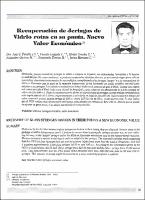| dc.contributor.author | Peralta, Ayar | |
| dc.contributor.author | Delgado C., Vicente | |
| dc.contributor.author | Concha U., Efraín | |
| dc.contributor.author | Quiroa M., Alejandro | |
| dc.contributor.author | Torrico H., Benjamín | |
| dc.contributor.author | Hernani C., Jaime | |
| dc.contributor.author | Instituto Peruano de Seguridad Social | |
| dc.date.accessioned | 2023-12-14T21:43:43Z | |
| dc.date.available | 2023-12-14T21:43:43Z | |
| dc.date.issued | 1995 | |
| dc.identifier.citation | Revista Médica del IPSS. 1995; 4(2). | es_PE |
| dc.identifier.issn | 1022-0240 | |
| dc.identifier.uri | https://hdl.handle.net/20.500.12959/4718 | |
| dc.description.abstract | Motivados, porque cuando las jeringas de vidrio se rompen en la punta, son desechadas (arrojadas a la basura o vendidas por kilo como chatarra), se propone recuperarlas dándoles otro uso, ya no como jeringas para colocar inyectables, sino como instrumentos de uso urológico, reemplazando a las jeringas "asepto" y a los evacuadores de Ellick o Alexander que se usan en la resección transuretral. Se ha inventado un anillo metálico especial para adaptar a las jeringas. Los cálculos económicos los hemos hecho en el supuesto de que el JPSS. Cuenta con cuatro mil camas en todo el Perú (ocho veces el total de Arequipa), y que, adquiere un aproximado de 3,840 jeringas de vidrio (de 50 y 100 ce.). Según lo informado por la oficina de adquisiciones las jeringas cuestan treinta o treintaicinco soles según sean de 50 ó 100 ce. respectivamente lo que daría un total de 118,400. OO. Valores muy por debajo del valor comercial actual, pues la jeringa de 100 ce. cuesta 127. 00, y la de 50 ce. 75. 00 nuevos soles. Lo que indica que el IPSS emplea más de trecientos mil nuevos soles anuales en jeringas de 50 ó 100 ce. Dinero que se puede recuperar en gran parte, si se aplica este método de recuperación. | es_PE |
| dc.description.abstract | Motivated by the fact that whenever glass syringes are broken in their points, they are disposed (thrown away to the garbage or sold in kilograms as junk); I propose to recover them by giving the syringes another use, no any replacing this way, to the "asepto" syringes and to the Ellick or Alexander evacuators used in the transurethral resection. We have invented a special metal ring in order to adapt it to the syringes. The economic calculus made supposing that the IPSS has four thousand beds all over the country (eight times more than the total of Arequipa), and that it acquires approximately 3,840 glass syringes (of 50 ce. and 100 ce.). According to the information given by the Office of Acquisitions, the 50 and 100 ce. syringe price 127. 00 new suns and the 50 ce. syringe price 75. 00 nuevos soles. This demonstrates that the IPSS would spend annually more than 300,000 new suns in 50 and 100 ce. syringes. This amount of money might be recovered in a large scale if my proposal is applied. | es_PE |
| dc.format | application/pdf | es_PE |
| dc.language.iso | spa | es_PE |
| dc.publisher | Seguro Social de Salud (EsSalud) | es_PE |
| dc.rights | info:eu-repo/semantics/openAccess | es_PE |
| dc.rights.uri | https://creativecommons.org/licenses/by-nc-sa/4.0/ | es_PE |
| dc.subject | Jeringas de vidrio | es_PE |
| dc.subject | Valor económico | es_PE |
| dc.subject | Glass syringes | es_PE |
| dc.subject | Economic value | es_PE |
| dc.title | Recuperación de jeringas de vidrio rotas en su punta. Nuevo valor económico | es_PE |
| dc.title.alternative | Recovery of glass syringes broken in their points a new economic value | es_PE |
| dc.type | info:eu-repo/semantics/article | es_PE |
| dc.subject.ocde | https://purl.org/pe-repo/ocde/ford#3.03.01 | es_PE |






